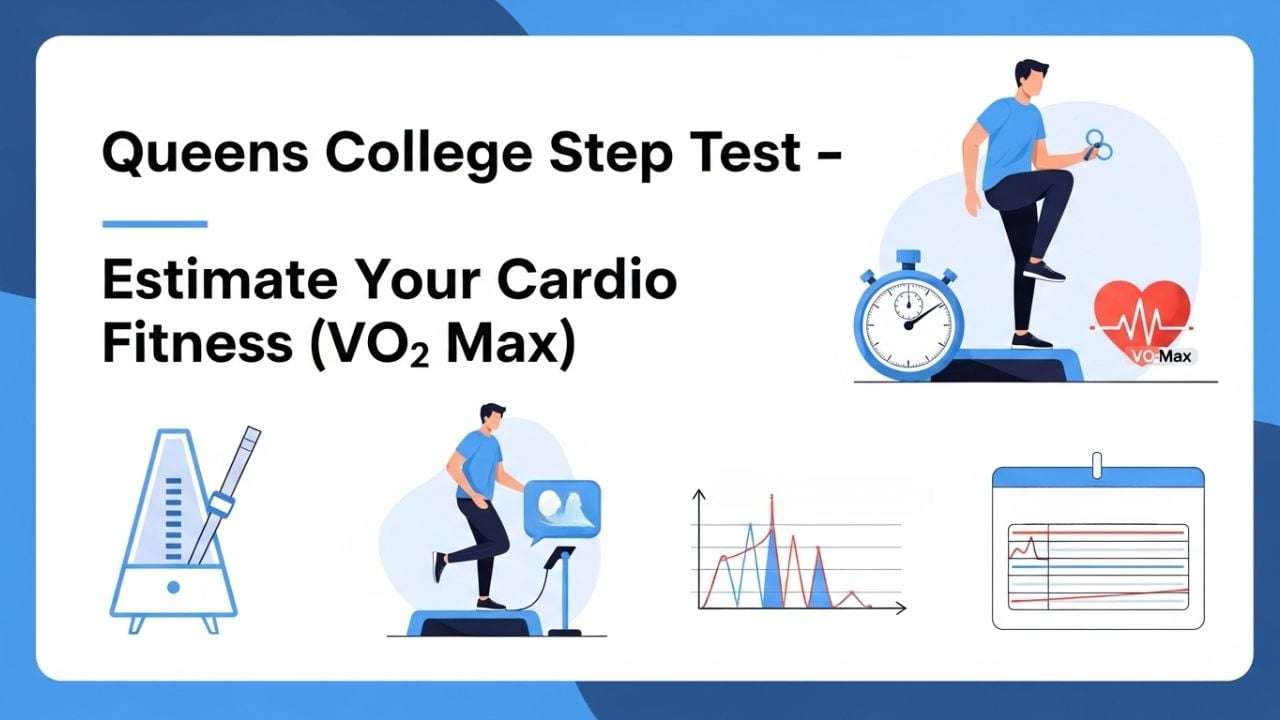Queens College Step Test Calculator
Calculate your VO2 Max using the scientifically validated Queens College Step Test with official formulas for accurate cardiovascular fitness assessment

What is the Queens College Step Test?
The Queens College Step Test (QCST) is a scientifically validated submaximal exercise test for predicting VO2 max. Research by Chatterjee et al. (2004) demonstrates strong correlation (r=0.95) between step test performance and actual VO2 max measurements, making it an excellent field test for cardiovascular fitness assessment.
Why Use the Queens College Step Test?
The QCST offers several advantages over other fitness tests: it’s time-efficient (3 minutes), requires minimal equipment, has high validity (90-95% correlation with laboratory testing), and is suitable for most populations. Unlike maximal tests, it’s safer and more practical for large-scale fitness assessments.
Scientific Validation
Validation research demonstrates the QCST as highly reliable and valid for fitness assessment across diverse populations, with consistent results when administered under standardized conditions.
Queens College Step Test Formulas & Calculations
VO2 Max Fitness Standards
| Age Group | Gender | Poor | Fair | Average | Good | Excellent |
|---|---|---|---|---|---|---|
| 20-29 | Male | <25 | 25-33 | 34-42 | 43-52 | >52 |
| Female | <23 | 23-28 | 29-34 | 35-44 | >44 | |
| 30-39 | Male | <23 | 23-30 | 31-39 | 40-48 | >48 |
| Female | <20 | 20-25 | 26-31 | 32-40 | >40 | |
| 40-49 | Male | <20 | 20-27 | 28-35 | 36-44 | >44 |
| Female | <17 | 17-22 | 23-28 | 29-36 | >36 | |
| 50-59 | Male | <18 | 18-24 | 25-32 | 33-40 | >40 |
| Female | <15 | 15-20 | 21-25 | 26-32 | >32 | |
| 60+ | Male | <16 | 16-22 | 23-28 | 29-36 | >36 |
| Female | <13 | 13-17 | 18-23 | 24-30 | >30 |
Test Administration Protocol
Pre-Test Preparation
- Equipment: 16.25-inch bench, metronome, stopwatch
- Environment: Cool, well-ventilated area
- Participant: Comfortable clothing, proper footwear
- Medical clearance: Ensure participant health status
Test Execution
- Duration: Exactly 3 minutes continuous stepping
- Pattern: Up-up-down-down (both feet)
- Cadence: Males 24/min, Females 22/min
- Posture: Upright, full leg extension
Heart Rate Measurement
- Timing: 15 seconds after test completion
- Method: Radial or carotid pulse
- Duration: 15-second count × 4 = BPM
- Accuracy: Start counting exactly at 5 seconds
Safety Considerations
- Monitoring: Watch for signs of overexertion
- Termination: Stop if participant feels faint
- Recovery: 5-10 minutes cool-down walking
- Hydration: Water available post-test
Research Validation & Scientific Basis
Primary Research Foundation
“Validity of Queen’s College Step Test for Estimation of Maximum Oxygen Uptake”
Chatterjee et al. (2004) –
This landmark study validated the QCST with 95% correlation to laboratory VO2 max testing, establishing it as the gold standard for field-based cardiovascular fitness assessment.
Cross-Population Validation
“Cross-Cultural Validation Studies”
International Research –
Multiple studies across different populations confirm the test’s validity, with correlation coefficients consistently above 0.90 with laboratory measurements.
Applications & Uses
🏫 Educational Settings
Standard fitness assessment in physical education programs, kinesiology research, and health promotion courses. The test’s simplicity and accuracy make it ideal for large-scale student fitness evaluations.
🏢 Occupational Health
Pre-employment fitness screening for physically demanding jobs, workplace wellness programs, and occupational health assessments. The submaximal nature makes it suitable for diverse employee populations.
🏥 Clinical Applications
Cardiac rehabilitation programs, fitness assessments for special populations, and research studies requiring cardiovascular fitness data. The test’s safety profile makes it appropriate for clinical settings.
⚕️ Medical Disclaimer
This Queens College Step Test calculator provides estimates based on validated scientific formulas and should not replace professional medical advice. Individual performance can vary significantly due to health status, medications, and other factors. Consult with healthcare providers before beginning any fitness testing program, especially if you have cardiovascular conditions, joint problems, or other health concerns. The test should only be administered by qualified professionals in appropriate settings.
Related
- Burpee Calories Burned Calculator
- Crunches Calories Burned Calculator
- Sit-Up Calories Burned
- Zumba Calories Burned Calculator
- Pull Up Calories Burned Calculator
- Push-Up Calories Burned Calculator
- Home Activities Calories Burned Calculator
- Exercise Calories Burned Calculator
- Running Calorie Calculator
- Walking Calorie Burned Calculator
References
- Chatterjee S, Chatterjee P, Mukherjee PS, Bandyopadhyay A. Validity of Queen’s College step test for use with young Indian men. Br J Sports Med. 2004 Jun;38(3):289-91. doi: 10.1136/bjsm.2002.002212. PMID: 15155428; PMCID: PMC1724834.
- Molanouri Shamsi, Mahdieh & Agha-Alinejad, Hamid & Ghaderi, Mohammad & Kamal, Talebi & Badrabadi,. (2011). Queen’s College Step Test Predicted VO 2Max : The Effect of Stature. Annals of Biological Research,. 2. 371-377.
- Pandya, Rachana Ashishkumar; Kaydawala, Batul A; Purohit, Manthan H; Sheth, Megha Sandeep. Effect of physical parameters on Queens College Step Test performance in young adults of Ahmedabad, Gujarat, India: An observational study. Journal of Society of Indian Physiotherapists 8(1):p 1-4, January-June 2024. | DOI: 10.4103/jsip.jsip_66_23
- Chatterjee, Satipati & Chatterjee, Pratima & Bandyopadhyay, Amit. (2005). Validity of Queen’s College Step Test for estimation of maximum oxygen uptake in female students. The Indian journal of medical research. 121. 32-5.

Manish is a NASM-certified fitness and nutrition coach with over 10 years of experience in weight lifting and fat loss fitness coaching. He specializes in gym-based training and has a lot of knowledge about exercise, lifting technique, biomechanics, and more.
Through “Fit Life Regime,” he generously shares the insights he’s gained over a decade in the field. His goal is to equip others with the knowledge to start their own fitness journey.
